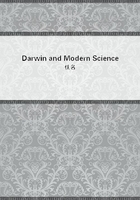
第305章
In my account of these remarkable systems the consideration of one very important conclusion has been purposely deferred. Since the light-curve is explicable by eclipses, it follows that the sizes of the two stars are determinable relatively to the distance between them. The period of their orbital motion is known, being identical with the complete period of the variability of their light, and an easy application of Kepler's law of periodic times enables us to compute the sum of the masses of the two stars divided by the cube of the distance between their centres. Now the sizes of the bodies being known, the mean density of the whole system may be calculated. In every case that density has been found to be much less than the sun's, and indeed the average of a number of mean densities which have been determined only amounts to one-eighth of that of the sun. In some cases the density is extremely small, and in no case is it quite so great as half the solar density.
It would be absurd to suppose that these stars can be uniform in density throughout, and from all that is known of celestial bodies it is probable that they are gaseous in their external parts with great condensation towards their centres. This conclusion is confirmed by arguments drawn from the theory of rotating masses of liquid. (See J.H. Jeans, "On the density of Algol variables", "Astrophysical Journ." Vol. XXII. (1905), page 97.)Although, as already explained, a good deal is known about the shapes and the stability of figures consisting of homogeneous incompressible liquid in rotation, yet comparatively little has hitherto been discovered about the equilibrium of rotating gaseous stars. The figures calculated for homogeneous liquid can obviously only be taken to afford a general indication of the kind of figure which we might expect to find in the stellar universe. Thus the dotted curve in Fig. 5, which exhibits one of the figures which I calculated, has some interest when placed alongside the figures of the stars in RR Centauri, as computed from the observations, but it must not be accepted as the calculated form of such a system. I have moreover proved more recently that such a figure of homogeneous liquid is unstable. Notwithstanding this instability it does not necessarily follow that the analogous figure for compressible fluid is also unstable, as will be pointed out more fully hereafter.